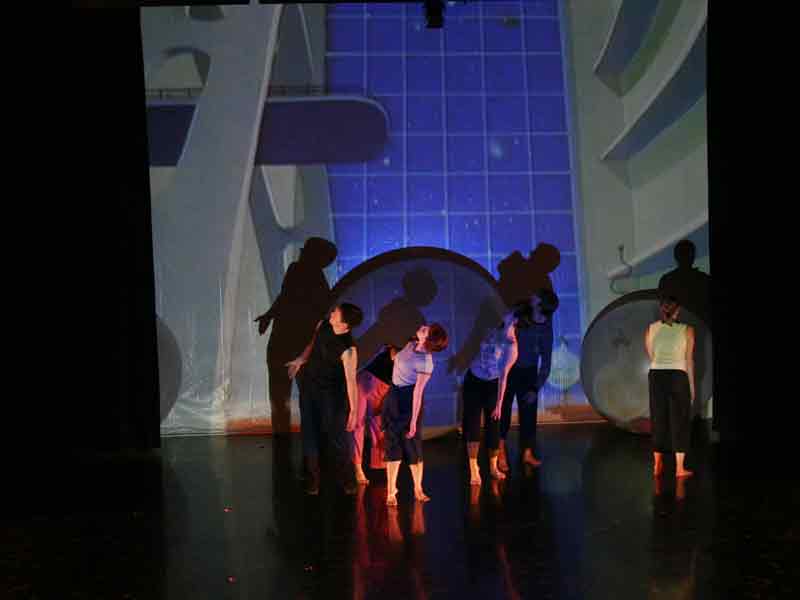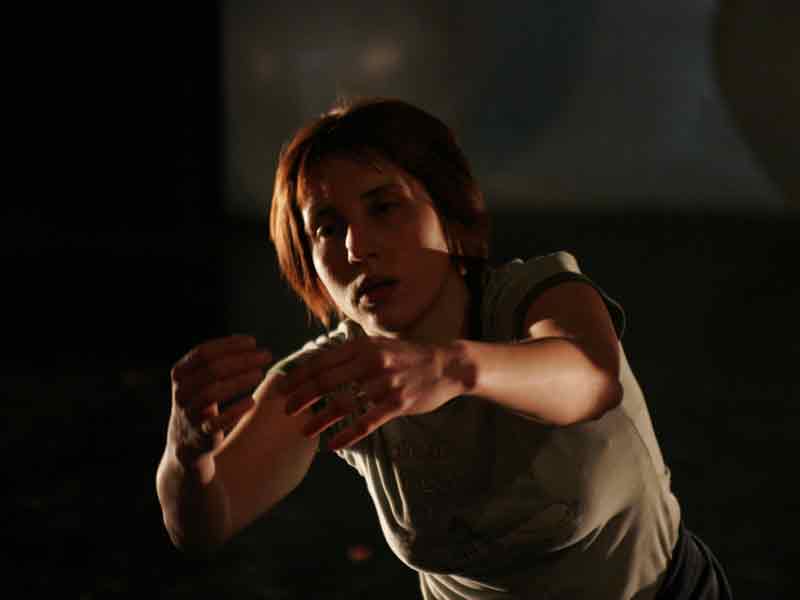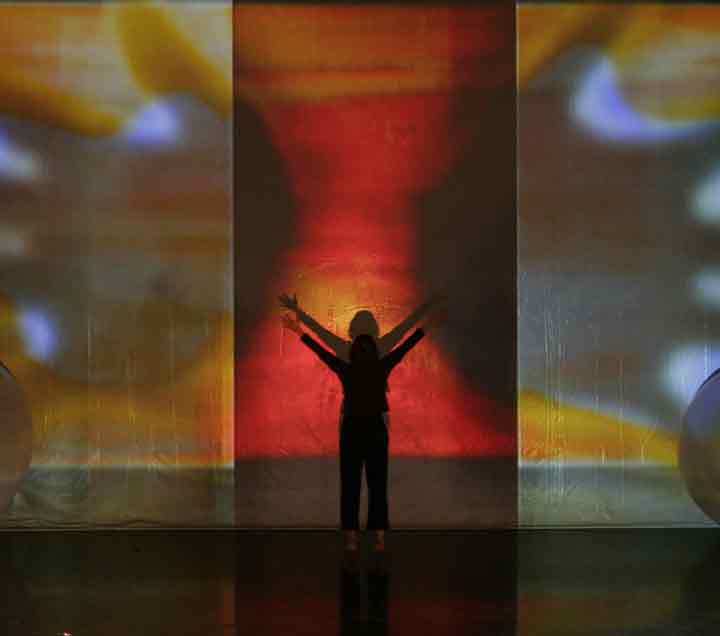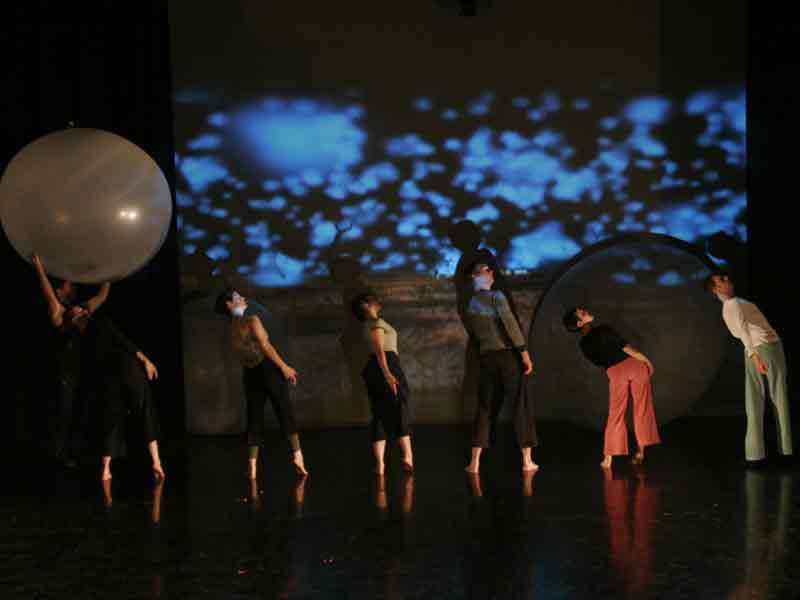Dancing through the Train Wreck: Time Track Productions at the Southern
Lightsey Darst reviews "The Train Wreck Is Proceeding Nicely," a new-media and dance extravaganza at the Southern Theater.




In “The Train Wreck is Proceeding Nicely,” Paula Mann and Steve Paul’s fable about American public life, we enter a time of political hysteria and plastic happiness, of imminent destruction and immediate gratification—in other words, the 1950s, that Rorschach blot of a decade. The Bomb looms over our present, an incomprehensible death, but it also blooms in glorious Technicolor like a South Pacific orchid; we fear and desire it at once, like children who can’t believe that they can bleed. The future’s a Ford dealer’s window, bright, airtight, kissproof. And the past is oblivion and fear: fear of what you did, whom you talked to, oblivion over what you wanted before you knew better, before our time.
Mann and Paul choose three groups to represent the fifties. J. Robert Oppenheimer (played by three dancers) is caught up in the motion, the science, but questions the aim; he’s noble, but helpless (and a little naïve) before the drive of the nation. The Oppenheimer section is the least successful. Three dancers lie with their heads together, repeating, “My name is J. Robert Oppenheimer,” with great emphasis, in canon. Their sincerity deadens; we know we should feel something, but what? And why? The onus of emotion rests with the audience.
The main corps of dancers represent ordinary Americans, the blindly enthusiastic inhabitants of this fake world. These believers are far more interesting. Mann endows them with jerky, hippy moves and makes them elbow and kick each other with savage glee; they grin and mug and shout. They love cigarettes and game shows and dream about the future, but their shiny civilization’s only skin-deep. Their handshakes begin salesman-style but end as wrestling matches. Their hidden animalism, rather than their superficiality, offers most dramatic promise, but we get a little of the first and a lot of the second. Does some of this loss rest with the dancers? They act with enthusiasm and show real comedic skill (watch especially Kim Richardson and Robert Haarman), but they seem more invested in their acting than in their dancing.
The ordinary Americans are fun to watch, but for emotion, we must wait for the sporadic appearances of the victim. The victim, danced by Paula Mann, almost always appears alone. She’s silent; except for a strange shit-eating grin (meant to appease?) that spreads across her face at her first appearance, she’s unaware of us. The victim’s dance is radioactive torque, not a choice or an act, and Mann silences all mental static with her integral performance. If the victim’s life has been sacrificed to the pleasure of the ordinary Americans, though, we need some connection drawn between the two. Although Mann and Paul have created a satisfying conclusion to “Train Wreck,” there’s no moment of recognition or responsibility; the victim does not touch the rest of the performance.
Mann and Paul aim high with their complex scenario—they want comedy, tragedy, history, and satire. If they don’t entirely succeed, their reach still thrills. The same is true of their method. “Train Wreck” combines dialogue, choreography, film, music, and animation. Sometimes the effect’s overwhelming: Mann stands in the center of the stage, her back to the audience, fingers splayed out to her sides, while radioactive heat spreads from her hands across paper screens and over the stage, and a heart’s beat thumps. Videogame-style animation produces two of the most successful sequences. In one, two dancers reach jaggedly across each other in a parody of connection, while M. C. Escher staircases move up and down without hope of arrival. In the other, dancers race from the front of the stage to the back, desperate; behind them a desolate landscape zooms away. Steve Paul’s mesmerizing animation and manic collages match Paula Mann’s sharp-edged, intense choreography. At its best, the media mix blurs, and you experience “Train Wreck” not as sight or sound but as lightning.
When “Train Wreck” plays with words, though, the performance bogs down. Sometimes tedious, sometimes gross (and sometimes, I have to admit, grossly funny) the script isn’t good enough for the rest of the performance. It isn’t even necessary. Perhaps the only words “Train Wreck” needs come at the end. Weather balloons, which have served as curved projection screens, spinning planets, and stylized mushroom clouds (another example of Mann and Paul’s highly wrought design), descend onto the supine Americans. While the dancers bounce these heavy, suffocating toys, J. Robert Oppenheimer, projected behind them, remembers the first bomb tests. “Now,” he says, using the words of the many-armed god Shiva, “I have become death.”